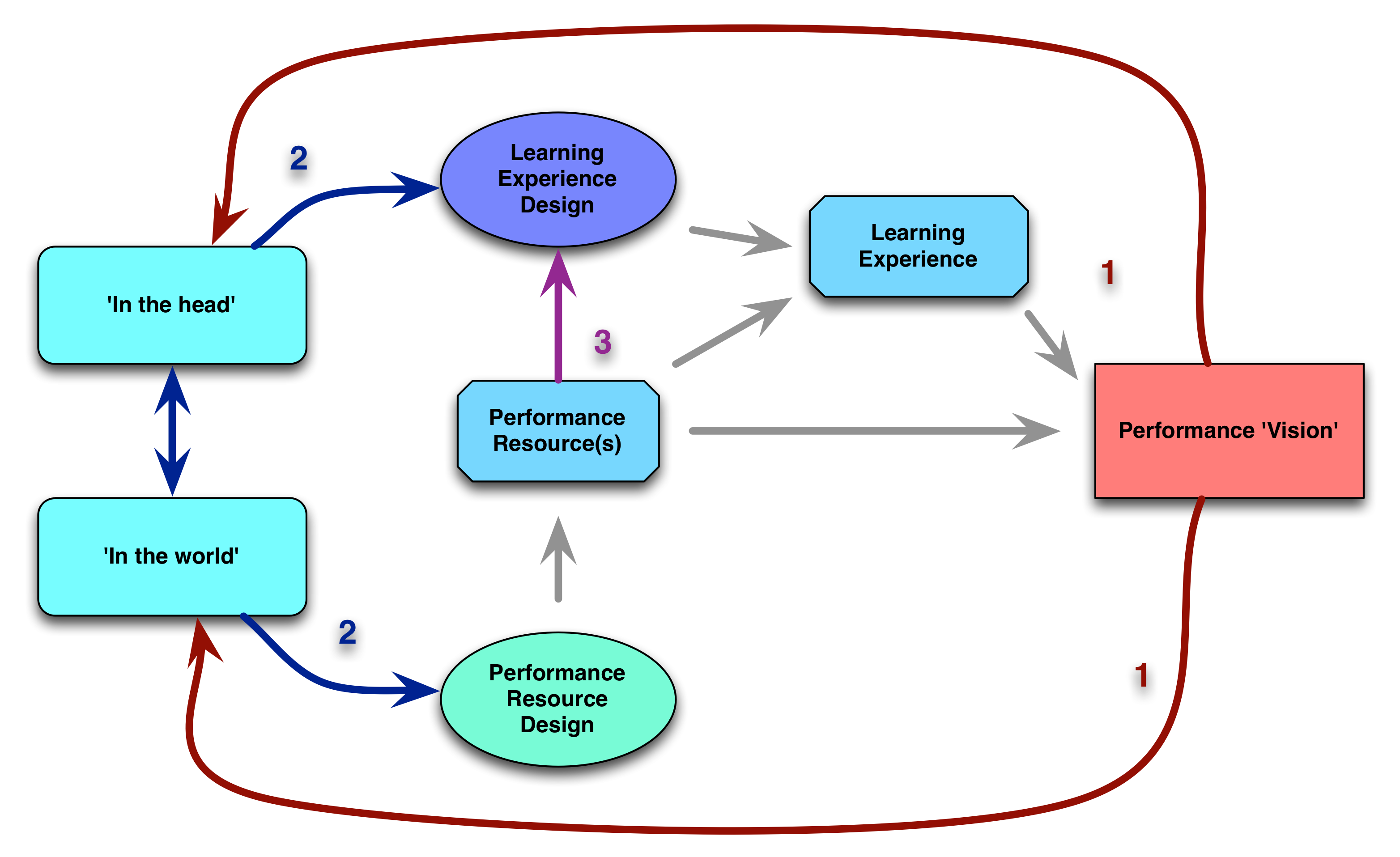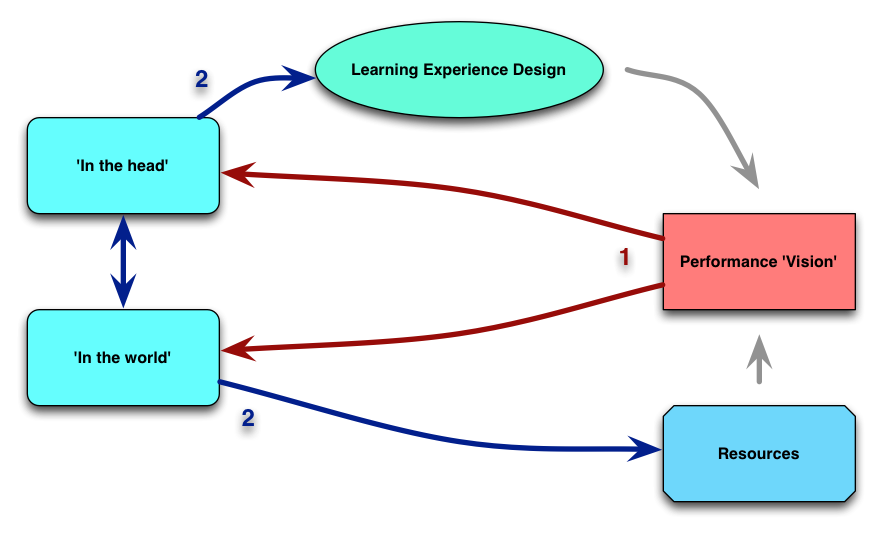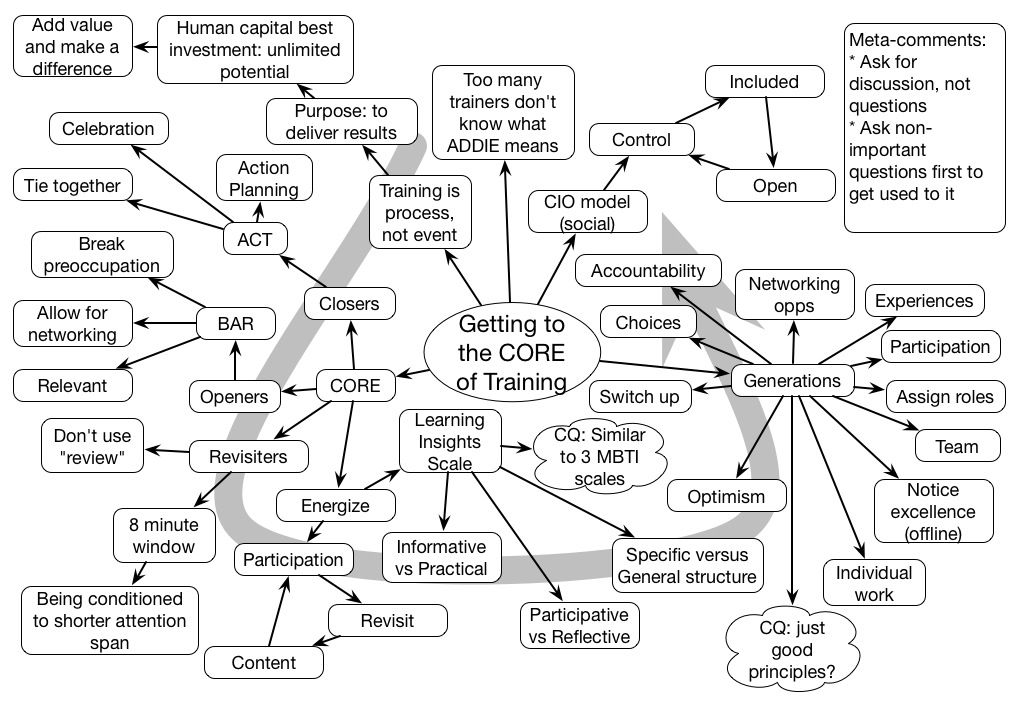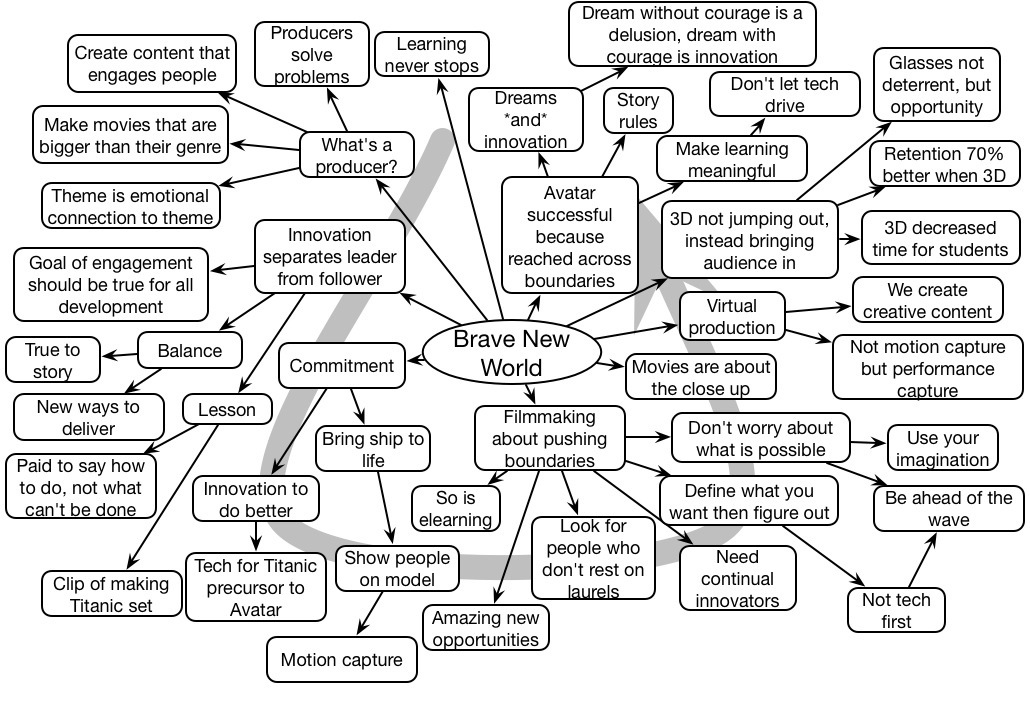Bob Pike launched the third and final day of ASTD’s Middle East and North Africa event with a keynote that took some well-established principles of good learning design and put his own unique and engaging spin on them. Along the way he discussed learning styles (in a different phrase) and generations. And he certainly practices what he preaches.
Refining Designing
A couple of months ago, I posted on thinking about designing, calling for designing ‘backwards and forwards’. And it’s continued to percolate, rightly or wrongly.
As I originally structured it, you worked backwards (1) from the ultimate performance you need to put information in the head, and in the world, and then designed forward (2) the combined learning experience, and the performance resource. While the HPT movement thinks about this as well (they definitely talk about whether it should be a learning or performance support solution; I don’t know but assume they will do a mix if needed). Which I don’t disagree with, but I realized I needed to address one issue.
 It occurred to me that when you design your resource(s), that has to happen first. If there are resources, they should be included in the learning experience. That is, you want to provide practice with the resources as part of the learning experience to develop the performer’s ability to use the resources in the performance situation.
It occurred to me that when you design your resource(s), that has to happen first. If there are resources, they should be included in the learning experience. That is, you want to provide practice with the resources as part of the learning experience to develop the performer’s ability to use the resources in the performance situation.
Thus, I’ve ended up redesigning it such that performance resource(s) influence the learning experience design (3), and are available in the learning experience as well as in the performance environment. It’s more complex, but more accurately captures the types of thinking we need to have as designers. We need to create what’s in the world and then prepare what’s in the head to accommodate the new performance environment.
Which, of course, may actually need to be iterative. As Atul Gawande points out in his book, his checklists were rigorously trailed and refined. That sort of evaluation and revision should be part of our ongoing processes too. We shouldn’t assume we’ll get it perfect the first time. And the existing environment prior to our intervention will also factor into our resource and experience design.
That said, does this conceptualization help? I’m trying to find ways to represent design that helps reduce our overemphasis on all training being about trying to put everything ‘in the head’, and this, combined with my earlier thoughts on learning experience design, is part of my ongoing effort. If, however, it’s either too confusing, or already common knowledge, I need to work more. Feedback?
Vale David Jonassen
David Jonassen passed away on Sunday. He had not only a big impact on the field of computers for learning, but also on learning itself. And he was a truly nice person.
I had early on been a fan of his work, his writing on computers as cognitive tools was insightful. He resisted the notion of teaching computing, and instead saw computers as mind tools, enablers of thinking. He was widely and rightly regarded as an influential innovator for this work.
I also regularly lauded his work on problem-solving. The one notion that really resonated was that the problems we give to kids in schools (and too often to adults in training) bear little resemblance to the problems they’ll face outside. He did deep work on problem-solving that more should pay attention to. He demonstrated that you could get almost as good a performance on standard tests using meaningful problems, and you got much better results on problem-solving skills (21st century skills) as well. I continue to apply his principles in my learning design strategies.
I had the opportunity to meet him face to face at a conference on learning in organizations. While I was rapt in his presentation, somehow it didn’t work for the audience as a whole, a shame. Still, I had the opportunity to finally talk to him, and it was a real pleasure. He was humble, thoughtful, and really willing to engage. I subsequently shared a stage with him when he presented virtually to a conference I was at live, and was thrilled to have him mention he was using my game design book in one of his classes.
He contributed greatly to my understanding, and to the field as a whole. He will be missed.
Designing Backward and Forward
At the recent DevLearn, several of us gathered together in a Junto to talk about issues we felt were becoming important for our field. After a mobile learning panel I realized that, just as mlearning makes it too easy to think about ‘courses on a phone’, I worry that ‘learning experience design’ (a term I’ve championed) may keep us focused on courses rather than exploring the full range of options including performance support and eCommunity.
So I began thinking about performance experience design as a way to keep us focused on designing solutions to performance needs in the organization. It’s not just about what’s in our heads, but as we realize that our brains are good at certain things and not others, we need to think about a distributed cognition solution, looking at how resources can be ‘in the world’ as well as in others’ heads.
The next morning in the shower (a great place for thinking :), it occurred to me that what is needed is a design process before we start designing the solution. To complement Kahnemann’s Thinking Fast and Slow (an inspiration for my thoughts on designing for how we really think and learn), I thought of designing backward and forward. Let me try to make that concrete.
 What I’m talking about is starting with a vision of what performance would look like in an ideal world, working backward to what can be in the world, and what needs to be in the head. We want to minimize the latter. I want to respect our humanity in a way, allowing us to (choose to) do the things we do well, and letting technology take on the things we don’t want to do.
What I’m talking about is starting with a vision of what performance would look like in an ideal world, working backward to what can be in the world, and what needs to be in the head. We want to minimize the latter. I want to respect our humanity in a way, allowing us to (choose to) do the things we do well, and letting technology take on the things we don’t want to do.
In my mind, the focus should be on what decisions learners should be making at this point, not what rote things we’re expecting them to do. If it’s rote, we’re liable to be bad at it. Give us checklists, or automate it!
From there, we can design forward to create those resources, or make them accessible (e.g. if they’re people). And we can design the ‘in the head’ experience as well, and now’s the time for learning experience design, with a focus on developing our ability to make those decisions, and where to find the resources when we need them. The goal is to end up designing a full performance solution where we think about the humans in context, not as merely a thinking box.
It naturally includes design that still reflects my view about activity-centered learning (which I’m increasingly convinced is grounded in cognitive research). Engaging emotion, distributed across platforms and time, using a richer suite of tools than just content delivery and tests. And it will require using something like Michael Allen’s Successive Approximation Model perhaps, recognizing the need to iterate.
I wanted to term this performance experience design, and then as several members workshopped this with me, I thought we should just call it performance design (at least externally, to stakeholders not in our field, we can call it performance experience design for ourselves). And we can talk about learning experience design within this, as well as information design, and social networks, and…
It’s really not much more than what HPT would involve, e.g. the prior consideration of what the problem is, but it’s very focused on reducing what’s in the head, including emotion in the learning when it’s developed, using social resources as well as performance support, etc. I think this has the opportunity to help us focus more broadly in our solution space, make us more relevant to the organization, and scaffold us past many of our typical limitations in approach. What do you think?
Experience, the API
Last week I was on a panel about the API previously known as Tin Can at #DevLearn, and some thoughts crystallized. Touted as the successor to SCORM, it’s ridiculously simple: Subject Verb Object: e.g. “I did this”, such as ‘John Doe read Engaging Learning’ but also ‘Jane Doe took this picture’. And this has interesting implications.
First, the API itself is very simple, and while it can be useful on it’s own, it’ll be really useful when there’re tools around it. It’s just a foundation upon which things can be done. There’ll need to be places to record these actions, and ones to pull together sequences of recommendations for learning paths, and more. You’ll want to build portfolios of what you’ve done (not just what content you’ve touched).
But it’s about more than learning. These can cross accessing performance support resources, actions in social media systems, and more. This person touched that resource. That person edited this file. This other person commented.
One big interesting opportunity is to be able to start mining these. We can start looking at evidence of what folks did and finding good and bad outcomes. It’s a consistent basis for big data and analytics. It’s also a basis to start customizing: if the people who touched this resource were better able to solve problem X, other people with that problem maybe should also touch it. If they’ve already tried X and Y, we can next recommend Z. Personalization/customization.
An audience member asked what they should take back to their org, and who needed to know what. My short recommendations:
Developers need to start thinking about instrumenting everything. Everything people touch should report out on their activity. And then start aggregating this data. Mobile, systems, any technology touch. People can self report, but it’s better to the extent that it’s automated.
Managers need to recognize that they’re going to have very interesting opportunities to start tracking and mining information as a basis to start understanding what’s happening. Coupled with rich other models, like of content (hence the need for a content strategy), tasks, learners, we can start doing more things by rules.
And designers need to realize, and then take advantage of, a richer suite of options for learning experiences. Have folks take a photo of an example of X. You can ask them to discuss Y. Have them collaborate to develop a Z. You could even send your learners out to do a flash mob ;).
Learning is not about content, it’s about experience, and now we have ways to talk about it and track it. It’s just a foundation, just a standard, just plumbing, just a start, but valuable as all that.
Jon Landau #DevLearn Keynote Mindmap
Learning There
A respected colleague recently suggested Andy Clark’s Being There as a read to characterize the new views of cognition, so I checked it out. The book covers the new emerging views of cognition, grounded in the connectionist revolution and incorporating a wide variety of neural and robotic studies. The interesting thing to me are the implications for learning and instruction.
The book makes the case that the way we think is not only heavily tied to our contexts, but that we co-construct the world in ways that affect our thinking in profound ways. Studies across economic behavior, animal cognition, simulation studies, and more are integrated to make the point that they way we think is very different than the models of conscious minds sitting in meat vehicles. Instead, we’re very driven from below and outside, and our conscious thinking is rare, hard, and language based. Moreover, the constructs we create to think affect our thinking, making it easier. We automate much not only through learning, but we externalize. And, our representations and understanding are very much constructed ‘on the fly’ in each new situations, as opposed to existing abstract and robust.
This isn’t easy reading. Clark is a philosopher of mind, and covers much complex research and deep neuroscience. The emergent picture, however, is of a mind very different than the cognitivist model. I’m grateful that while I pursued my PhD in Cog Psych, the research going on in our co-shared lab by Rumelhart and McClelland on connectionist networks sensitized me to this viewpoint, and Hutchins work on Cognition in the Wild was similarly taking place at the same time. Despite the challenge, there are important reasons to get our minds around this way of thinking.
The notion that providing abstract knowledge will lead to any meaningful outcome has already pretty much been debunked both empirically and theoretically. What these models seem to suggest is that what can and will work is deep scaffolded practice and guided reflection, based upon a situated cognition. For other reasons, this is the model that Collins and Brown had in Cognitive Apprenticeship, and now we’ve a more solid philosophical basis for it. (I also think that there are rejoinders to Kirschner, Sweller, & Clark, and Anderson, Reder, & Simon; discussing how language, including writing, is social, and that iterations between abstract models and meaningful practice is guided reflection.)
This model suggests that language is our differentiator, and that much of our higher level cognition is mediated through language. There’s a reason consciousness feels like a dialog. Much of our processing is beneath consciousness, and things we monitor and develop through language become compiled away inaccessible to language.
The point, to me, is that the activity-based learning model I’ve proposed has both bottom up grounding in new cognitive models, theoretical framing from anchored instruction and social constructivism, as well as empirical validity from apprenticeships and work-place learning. We need to start aligning our learning design to the cognitive realities.
Push the envelope further
When I run my game design workshop, one of the things I advocate is exaggeration. And you need to take this to heart in two ways: one is why it’s important, and the other is how to get away with it. That is, if you want learning to be as effective as possible.
When individuals perform in the real world, they’re motivated. There are consequences for failure, and rewards (tangible or not) for success. Yet in the learning experience, if we try to make it as real as possible, those motivations aren’t likely to be there. We want it to be safe to fail, so there aren’t quite the same consequences. How do we make it closer to the real context, to maximize transfer? Exaggerate the circumstances:
- You’re not working on a patient, you’re working to save the ambassador’s daughter
- You’re not just making a deal, you’re making the deal that the business is going to need to keep from going into receivership
- You’re not just designing a networking solution, you’re designing one to support the communications for the rebels overthrowing the oppressive regime
You get the idea. You have to avoid stereotypes, and it’s a delicate dance to make it something that the learners will not dismiss but buy as more interesting than if you played it straight. Still, it’s worth the effort. And testing’s a good idea ;).
You want these exaggerations not just for task-based motivation, but you also want to make it more meaningful to the learner. Tap into not only the right application of the decision in context, but also a context learners will care about.
How do you get away with this? You know that you’re going to get reined in, stakeholders are always so precious about their content (“you can’t be flip about X!”). So go further than you think you’ll get away with. You’ll get reined in, but then you’ll still end up at a reasonable place.
For example, we were doing a learning experience about using web tools, and learners were going to create a web site. If you want youth to do it, we could’ve gone in different directions: a site for some environmental need, or for a subversive organization. In this case, we decided it would be plausible (larger context was a design agency) to do a client band.
If we’d said rock band, we’d be reined back to a pop band. Instead, we chose Goth Polka (and were surprised to find that it exists), and had a band name of the Death Kloggerz (in appropriate font). The client reined us in, because Death was too far for them to countenance, so we ended up with the Dark Kloggerz. Still, we got to keep in the odd elements that we felt were appropriate to keep it from being too banal.
The stakeholders will rein you in, but fight for the extreme. Your learners will thank you.
Focus on ‘do’
I’ve been working on a project where we’re reviewing the curriculum before we design the learning outcome. The level of detail is admirable: courses are defined by objectives, which then drive learning objectives, from which are extracted key concepts to present. And I’m finding one approach that’s making this go really well.
There are problems with the existing content. Some of the learning objectives are too specific, leading to an interpretation that won’t lead to transfer beyond the classroom. Some of the coverage in objectives or concepts is biased, so some topics are not covered enough, and others too much. Some of the learning objectives are focused on tasks that were clearly designed to incite learner interest, but not in an intrinsic way. And I’m not a domain expert, but I can still apply enough real world knowledge to make this determination (and we’ll review with SMEs).
What’s providing a very useful lever in identifying these gaps, even prior to remedying them, is a rabid focus on ‘do‘. That is: “what will the learner be able to do with this after the class”. Implied are two things: 1) that the learner will care about , and 2) that will let them have an impact somewhere.
This focus is letting me see that some things are so specific that they won’t generalize anywhere interesting; to identify that some of the goals are not really relevant anywhere else (e.g. a focus on ‘celebrity’ examples). That the coverage is spotty and some topics that have applicability have been skipped.
Such a focus will, I think, help in the discussions with the SMEs, and provide a way to work with them to get good outcomes for the learning and the learners. It’s a learning-centered approach (I think that’s a better phrase than learner-centric) that helps us meet the client’s goals in ways they understand.
What do you think?
The third goal of learning
I’ve regularly told workshop and talk attendees that our learning goals are twofold. It may be time to amend that.
Formally, our goals for learning interventions should be retention over time until needed and transfer to all appropriate situations (and no inappropriate ones). And these are important goals. If the learning’s atrophied by the time it’s needed, it’s of no use. If we don’t activate the learning in all relevant situations, we’re missing opportunities.
But it occurred to me there may be more. I was working with a group developing a certification in a particular area, based upon their wildly successful workshops. One of the outcomes they talked about, in an endeavor that occurs with a very high amount of stress, was that one of their outcomes was confidence on the part of the attendees.
It struck me that confidence on the part of the learner is very much a desirable, maybe even necessary outcome of any really successful learning. I regularly talk about the importance of the emotional component of successful learning: supporting motivation and reducing anxiety, and working to create a trajectory of building confidence. That confidence should be an outcome as well.
Too often we practice until we get it right, instead of until we can’t get it wrong. Add to that the learner knowing they’re fully capable of performing right, and we’re there’re. We have to continue to address the emotional side of the equation as well as the cognitive. It’s part of experience design. (And, now, I’ve got to go change my presentations ;)

